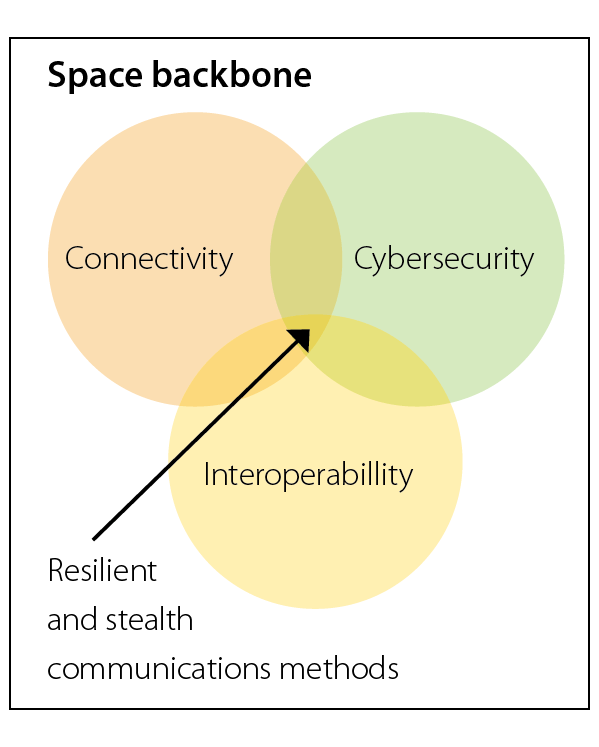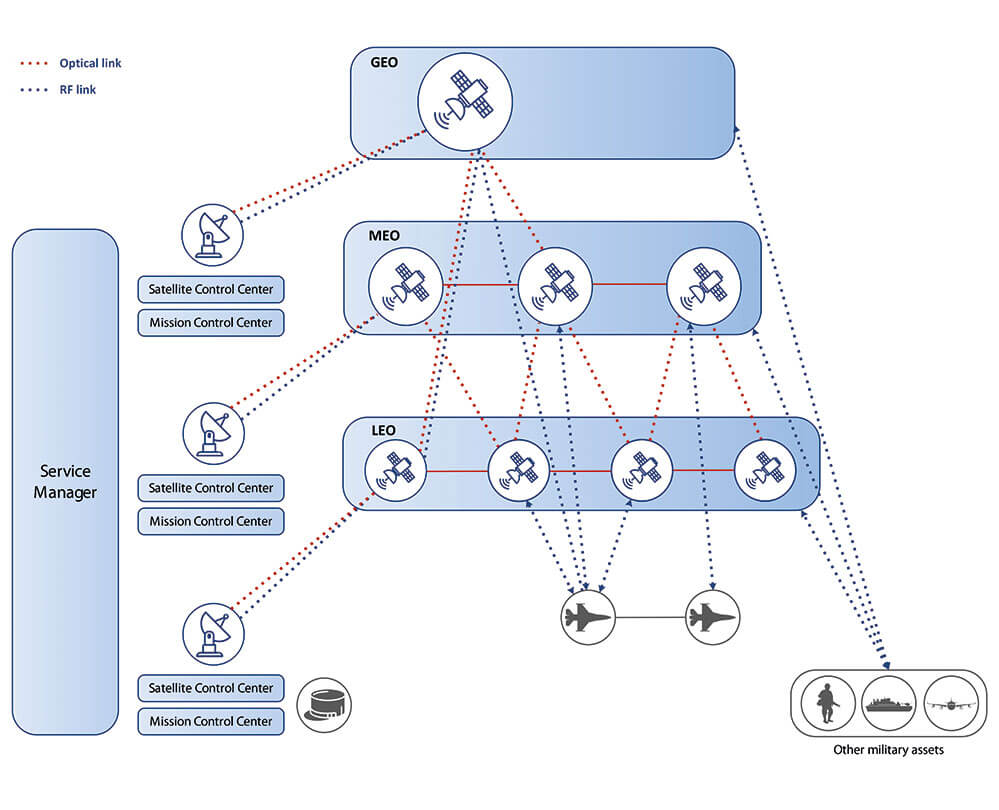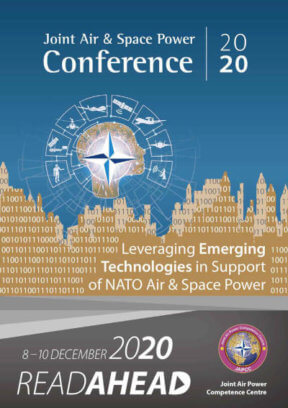Introduction
Connectivity is a key requirement for a Future Combat Air System (FCAS). The amount of secured information to be shared among forces is increasing. Data access and processing capability appear as a game-changer to improve situational awareness leading to decision and action superiority. The Space segment can be seen as a major cornerstone of the End-to-End connectivity for air combat systems. In the following article, the author will highlight the main system requirements to be considered for such a satellite communication system, taking into account service needs from an end-user perspective, and will provide preliminary system design to answer operational forces’ needs. A roadmap will also be proposed, with associated technological developments.
Main System Requirements

Space system.
Airbus is building complex systems for both commercial and military applications and is gathering customers’ requirements and needs to define a suitable space aero-connectivity solution. Based on first inputs, the space system shall comply with the following requirements.
Secured high data rates communication services. Security is a key requirement for military forces. Furthermore, the amount of data to be collected by fighter aircraft should increase in the future mainly because of distributed computation, storage (cloud-based approach) and information size (e.g. high-resolution images). Low Probability of Intercept (LPI) and Low Probability of Detection (LPD) capabilities are also requested for the communications services.
Global coverage. Areas for military operations may not be local (limited to a given country). The system shall be able to cover the full Earth, including polar areas.
Near real-time connectivity. Time to receive information and to react are important to achieving and maintaining superior speed of action in combat. The system shall support latency lower than tens of milliseconds.
Reconfiguration capability. Communication systems are evolving (e.g. new air interfaces, new routing concepts). Furthermore, the system shall be able to support coverage, frequency and power flexibility allowing fighters to be covered everywhere, every time. The connectivity system shall be able to be reconfigured in real-time, taking into account the air platform’s position and capacity requests during the different operational phases (training, blue areas, red areas)
Multi-customer operations capability is needed to allow joint forces to share connectivity resources in complex military operations.
Preliminary System Design
The authors are advocating a Military/Governmental multi-layer constellation system that will allow forces from different countries to share network and radio resources (military & governmental highway connectivity system).
The need for global coverage will basically be fulfilled through a polar constellation (Low Earth Orbit – LEO or Medium Earth Orbit – MEO). Each satellite shall be considered as a network node of a global combat cloud system providing advanced connectivity concepts. The emerging and increasing secured services needs for military aero-connectivity will lead to an increase in satellite performance in the future. This concerns at least three aspects:
- An increase in system capacity which can be achieved through investigation of several means such as more beams, more power, more gain or more spectrum (mainly a growing size approach of the space segment) but also through a more efficient satellite architecture and associated resource management.
- An increase in flexibility to better serve non-uniform traffic distribution and in particular the hot spots. The flexibility requirements relate to several aspects such as power, coverage and spectrum flexibility.
An increase in system security through advanced and reconfigurable air interfaces including ciphering aspects and stealth features (avoid detection from red forces). The space system configuration and monitoring links will be hardened to secure satellite and system operations. Furthermore the space system will be designed to provide communication resiliency (maintain connectivity links in case of system failures – e.g. satellite loss), a key requirement for information war.

Main Technologies to be Considered
In that context, several technical trends and new technologies appear of interest for an advanced secured satellite communication system design. At least five of them have been identified as promising concepts:
- Advanced routing with satellite processors embedding network routing capabilities, on-board modulation and demodulation. The more recent satellite communication technologies are key elements for information and traffic management – most notably by ensuring on-board autonomy and decision making, and thus optimizing system flexibility and resiliency.
- Advanced interference management. Jamming detection, spectrum monitoring and geolocation features are key assets for a secured air connectivity. Space solutions can be used to detect and localize potential threats thanks to advanced processing functions. In addition, use of active antennas can provide a key advantage to suppress interference or jammers and to avoid signal interception (stealth communication).
- Radio and network reconfiguration capability. These advanced technologies already deployed in ground systems are candidate solutions to support data links evolution and backward compatibility (e.g. capability to support at the same time new air interfaces as well as current Link-16). User terminal technology and tactical data links may change in the future and software communication techniques, such as Software Defined Radio (SDR) and Software Defined Network (SDN) would be candidate solutions to support these evolutions.
- Optical inter-satellite links. Interconnection within all the layers of the satellite communication system will avoid deployment of a ground-based relay and thereby reduce end-to-end latency. A space backbone distributed among the different orbits of the space segment (GEO, MEO, LEO) will provide full and rapid connectivity between several points of the Earth (tactical network with beyond line of sight capability).
- Dynamic resource management. Allocating radio and network resources to the end-users in real-time is critical, and a complex resource management system is needed which takes into account end-users’ connectivity needs, requested data rates, end-to-end latency, and jitter. Furthermore, in order to reduce the time to access space systems and shared resources among different countries, distribution of resource management functions between space system, next-generation fighters, communication ground equipment, (user terminals, gateways) and several operational centres is foreseen. It may also be possible to consider Artificial Intelligence to provide system resources in real-time (machine-learning concepts). Hybrid Ground, Space, Air resource management system will improve system resource allocation according to user needs and constraints.
Road to Next-generation Connectivity
Next-generation fighters systems are foreseen post-2035 in Europe. Space-based aero-connectivity needs to be fully operational at this time. However an incremental approach could be proposed to secure space system development and to allow current forces to access space connectivity prior to end of this decade. FCAS will be an incremental journey with several planned target architectures to achieve full collaborative combat. First set of capabilities are planned before 2030 preparing for the full FCAS vision with entry into service in 2040 of the New Generation Fighter teaming with Remote Carriers. Proposing technology demonstrators for such satellite system could be considered as a first step of a next-generation space connectivity system.
For instance, a first generation of satellite processor and optical inter-satellite connection could be used to test new air interfaces and network communication techniques prior to the development of a multi-layer Non-Geostationary Satellite Orbit (NGSO) constellation after 2030.
Conclusion
Taking into account requirements to be fulfilled by a Future Combat Air System made of connected manned and unmanned platforms, a space-based system would provide key required capabilities. Connectivity can drastically be improved (up to Beyond Line Of Sight – BLOS) allowing a collaborative air combat solution – forces from several countries sharing the same infrastructure. The vision then is that a detailed system design should be initiated, jointly with aeronautical forces from different countries, to deliver the best technical solution taking into account connectivity specific needs from each party. Space systems can also be used to propose additional services to fighter aircraft such as Intelligence, Surveillance and Reconnaissance (ISR), in addition to aero-connectivity.











